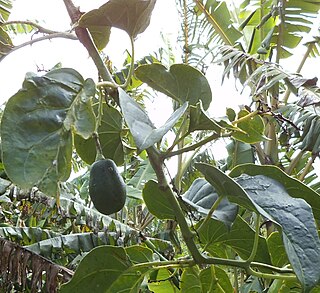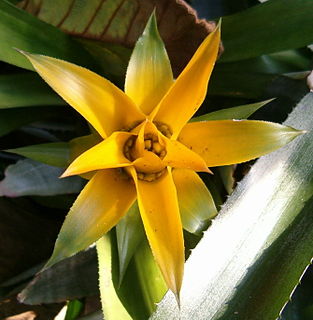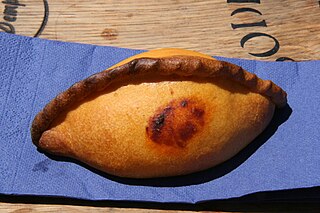
Solanum is a large and diverse genus of flowering plants, which include three food crops of high economic importance, the potato, the tomato and the eggplant. It also contains the nightshades and horse nettles, as well as numerous plants cultivated for their ornamental flowers and fruit.

A fruit tree is a tree which bears fruit that is consumed or used by humans and some animals — all trees that are flowering plants produce fruit, which are the ripened ovaries of flowers containing one or more seeds. In horticultural usage, the term "fruit tree" is limited to those that provide fruit for human food. Types of fruits are described and defined elsewhere, but would include "fruit" in a culinary sense, as well as some nut-bearing trees, such as walnuts.

Karamea is a town on the West Coast of the South Island of New Zealand. It is the northernmost settlement of any real size on the West Coast, and is located 96 kilometres (60 mi) northeast by road from Westport. There is no other connecting road to the town - the road north ends at the Kohaihai River some 20 kilometres (12 mi) from Karamea, at the southwestern end of the Heaphy Track.

The tamarillo is a small tree or shrub in the flowering plant family Solanaceae. It is best known as the species that bears the tamarillo, an egg-shaped edible fruit. It is also known as the tree tomato, tomate de árbol, tomate andino, tomate serrano, blood fruit, tomate de yuca, tomate de españa, sachatomate, berenjena and tamamoro in South America, and terong Belanda in Indonesia. They are popular globally, especially in Peru, Colombia, New Zealand, Ecuador, Rwanda, Australia, and the United States.

Solanum centrale, the kutjera, or Australian desert raisin, is a plant native to the more arid parts of Australia. Like other "bush tomatoes", it has been used as a food source by Central Australia and Aboriginal groups for millennia.
The team eventing event, part of the equestrian program at the 2004 Summer Olympics, was held from the 15–18 August 2004. For the first time since 1992, the team and individual contests ran concurrently. The team event used the results of the first three phases of the individual eventing program to award rankings. A fourth phase was included in the individual competition for the first time. The competition was held at the Olympic Equestrian Centre on the outskirts of Markopoulo, in the Attica region of Greece. Like all other equestrian events, the eventing competition was mixed gender, with both male and female athletes competing in the same division. 14 teams, each consisting of between three and five horse and rider pairs, entered the contest.

William Speed Lane Fox-Pitt is an English equestrian who competes in eventing. His career highlights include winning three Olympic medals in the team event, with silver in 2004 and 2012, and bronze in 2008. At the World Equestrian Games, he won team gold and individual silver in 2010, and team silver and individual bronze in 2014. He also won World team medals in 2002 and 2006. At the European Championships, he has won six team gold medals, as well as Individual silver in 1997 and 2005, and Individual bronze in 2013. He is the recordman CCI*****'s winner with 14 grand slam titles. In 2011, he became the first rider to win five different five-star events, having won the Burghley Horse Trials a record six times, Rolex Kentucky three times, Stars of Pau twice, the Badminton Horse Trials twice, and the Luhmühlen Horse Trials once (2008). A serious fall in 2015 left him in a coma for two weeks, but he came back to make the British eventing team and attend the 2016 Summer Olympics.

Colombian cuisine is a compound of the culinary traditions of the six main regions within the country. Colombian cuisine varies regionally and is particularly influenced by Indigenous Colombian, Spanish, and African cuisines, with slight Arab influence in some regions. Furthermore, being one of the most biodiverse countries in the world, Colombia has one of the widest variety of available ingredients depending on the region.
Tamarillo was a part-Arabian gelding that excelled in the sport of eventing under rider William Fox-Pitt.
Solanum cajanumense is a species of plant in the family Solanaceae. It is found in Colombia, Ecuador, and Peru.

Solanum sibundoyense is a species of plant in the family Solanaceae. It is endemic to Colombia, specifically to Sibundoy and surrounding areas, and usually resides in cloud forests, 1400–2300 meters in elevation. It is also known as tomate salvaje or tomate silvestre to natives of Colombia, and also sometimes called Cyphomandra sibundoyensis. It's a small tree 4–8 m tall. Stems glabrous or sparsely puberulent with glandular and eglandular hairs less than 0.5 mm long.

The Flora of Colombia is characterized by 130,000 species of plants that have been described within Colombian territory.
The Orto Botanico dell'Università di Perugia is a botanical garden operated by the University of Perugia. It is located at Borgo XX Giugno 74, Perugia, Umbria, Italy, and open to the public daily.

Biddesden House is a Grade I listed English country house in the parish of Ludgershall, Wiltshire. It is home to an Arabian Horse stud farm.

Canistropsis billbergioides is a species in the genus Canistropsis. This species is endemic to Brazil.
Dutch eggplant may refer to:

Bolivian cuisine stems from the combination of Spanish cuisine with indigenous ingredients and Aymara traditions, among others, with later influences from Germans, Italians, French, and Arabs due to the arrival of immigrants from those countries. The traditional staples of Bolivian cuisine are corn, potatoes, quinoa and beans. These ingredients have been combined with a number of staples brought by the Spanish, such as rice, wheat, and meat, including beef, pork, and chicken.

Solanum abutiloides is a species of plant in the family Solanaceae. It is endemic to Argentina and Bolivia, and thrives as a weedy plant in rocky land, on stream banks, and scrub land between 900–3,600 metres (3,000–11,800 ft) in elevation. It is also known as dwarf tamarillo, due to superficial similarities with Solanum betaceum. Both plants are noted for very rapid growth from seed, and very strongly fragrant foliage. Solanum abutiloides is also sometimes known by the archaic Cyphomandra sibundoyensis.

La Ceja del Tambo, often called simply La Ceja, is a town and municipality in the Antioquia Department of Colombia. It is part of the subregion of Eastern Antioquia. La Ceja borders the Rionegro and Carmen de Viboral municipalities to the north, La Unión to the east, and Montebello and Retiro to the west. It is located approximately 41 kilometers from Medellín, one of the main cities of the department.
The horticulture industry embraces the production, processing and shipping of and the market for fruits and vegetables. As such it is a sector of agribusiness and industrialized agriculture. Industrialized horticulture sometimes also includes the floriculture industry.













